Namibia
Coordinates: 22°S 17°E / 22°S 17°E
Republic of Namibia
|
||||||
|---|---|---|---|---|---|---|
|
||||||
| Motto: "Unity, Liberty, Justice" | ||||||
| Anthem: "Namibia, Land of the Brave" |
||||||
 Location of Namibia (dark blue) – in Africa (light blue & dark grey) |
||||||
| Capital and largest city | Windhoek 22°34.2′S 17°5.167′E / 22.5700°S 17.086117°E | |||||
| Official languages | English | |||||
| Recognised regional languages | ||||||
| Ethnic groups (2014) | Ethnic groups: | |||||
| Demonym | Namibian | |||||
| Government | Unitary semi-presidential republic[9][10] | |||||
| • | President | Hage Geingob | ||||
| • | Vice-President | Nickey Iyambo | ||||
| • | Prime Minister | Saara Kuugongelwa-Amadhila | ||||
| Legislature | Parliament | |||||
| • | Upper house | National Council | ||||
| • | Lower house | National Assembly | ||||
| Independence from South Africa | ||||||
| • | Constitution | 9 February 1990 | ||||
| • | Independence | 21 March 1990 | ||||
| Area | ||||||
| • | Total | 825,615 km2 (34th) 318,696 sq mi |
||||
| • | Water (%) | negligible | ||||
| Population | ||||||
| • | 2011 census | 2,113,077[11] | ||||
| • | Density | 2.54/km2 (235th) 6.6/sq mi |
||||
| GDP (PPP) | 2016 estimate | |||||
| • | Total | $27.035 billion[12] | ||||
| • | Per capita | $11,756[12] | ||||
| GDP (nominal) | 2016 estimate | |||||
| • | Total | $10.183 billion[12] | ||||
| • | Per capita | $4,427[12] | ||||
| Gini (2009) | 59.7[13] high |
|||||
| HDI (2014) | medium · 126th |
|||||
| Currency | Namibian dollar (NAD) | |||||
| Time zone | WAT (UTC+1) | |||||
| • | Summer (DST) | WAST (UTC+2) | ||||
| Drives on the | left | |||||
| Calling code | +264 | |||||
| ISO 3166 code | NA | |||||
| Internet TLD | .na | |||||
Namibia (![]() i/nəˈmɪbiə/, /næˈ-/),[15][16] officially the Republic of Namibia (German:
i/nəˈmɪbiə/, /næˈ-/),[15][16] officially the Republic of Namibia (German: ![]() Republik Namibia ; Afrikaans: Republiek van Namibië), is a country in southern Africa whose western border is the Atlantic Ocean. It shares land borders with Zambia and Angola to the north, Botswana to the east and South Africa to the south and east. Although it does not border Zimbabwe, a part of less than 200 metres of the Zambezi River (essentially a small bulge in Botswana to achieve a Botswana/Zambia micro-border) separates the two countries. Namibia gained independence from South Africa on 21 March 1990, following the Namibian War of Independence. Its capital and largest city is Windhoek, and it is a member state of the United Nations (UN), the Southern African Development Community (SADC), the African Union (AU), and the Commonwealth of Nations.
Republik Namibia ; Afrikaans: Republiek van Namibië), is a country in southern Africa whose western border is the Atlantic Ocean. It shares land borders with Zambia and Angola to the north, Botswana to the east and South Africa to the south and east. Although it does not border Zimbabwe, a part of less than 200 metres of the Zambezi River (essentially a small bulge in Botswana to achieve a Botswana/Zambia micro-border) separates the two countries. Namibia gained independence from South Africa on 21 March 1990, following the Namibian War of Independence. Its capital and largest city is Windhoek, and it is a member state of the United Nations (UN), the Southern African Development Community (SADC), the African Union (AU), and the Commonwealth of Nations.
The dry lands of Namibia were inhabited since early times by the San, Damara, and Nama peoples. Since about the 14th century, immigrating Bantu peoples arrived as part of the Bantu expansion. Since then the Bantu groups in total, known as the Ovambo people, have dominated the population of the country and since the late 19th century, have constituted a large majority.
In the late 19th century during European colonization, the German Empire established rule over most of the territory as a protectorate in 1884. It began to develop infrastructure and farming, and maintained this German colony until 1915, when South African forces defeated its military. After the end of World War I, in 1920 the League of Nations mandated the country to the United Kingdom, under administration by South Africa. It imposed its laws, including racial classifications and rules. From 1948, with the National Party elected to power, South Africa applied apartheid also to what was known as South West Africa. In 1878 the Cape Colony had annexed the port of Walvis Bay and the offshore Penguin Islands; these became an integral part of the new Union of South Africa at its creation in 1910.
In the later 20th century, uprisings and demands for political representation by native African political activists seeking independence resulted in the UN assuming direct responsibility over the territory in 1966, but South Africa maintained de facto rule. In 1973 the UN recognised the South West Africa People's Organisation (SWAPO) as the official representative of the Namibian people; the party is dominated by the Ovambo, who are a large majority in the territory. Following continued guerrilla warfare, South Africa installed an interim administration in Namibia in 1985. Namibia obtained full independence from South Africa in 1990. But Walvis Bay and the Penguin Islands remained under South African control until 1994.
Namibia has a population of 2.1 million people and a stable multi-party parliamentary democracy. Agriculture, herding, tourism and the mining industry – including mining for gem diamonds, uranium, gold, silver, and base metals – form the basis of its economy. The large, arid Namib Desert has resulted in Namibia being overall one of the least densely populated countries in the world. Namibia enjoys high political, economic and social stability.
History
The name of the country is derived from the Namib Desert, considered to be the oldest desert in the world.[17] Before its independence in 1990, the area was known first as German South-West Africa (Deutsch-Südwestafrika), then as South-West Africa, reflecting the colonial occupation by the Germans and the South Africans (technically on behalf of the British crown reflecting South Africa's dominion status within the British Empire).
Pre-colonial period
The dry lands of Namibia were inhabited since early times by San, Damara, and Nama. From about the 14th century, immigrating Bantu peoples arrived during the Bantu expansion from central Africa. From the late 18th century onwards, Oorlam people from Cape Colony crossed the Orange River and moved into the area that today is southern Namibia.[18] Their encounters with the nomadic Nama tribes were largely peaceful. The missionaries accompanying the Oorlam were well received by them,[19] the right to use waterholes and grazing was granted against an annual payment.[20] On their way further northwards, however, the Oorlam encountered clans of the Herero at Windhoek, Gobabis, and Okahandja, who resisted their encroachment. The Nama-Herero War broke out in 1880, with hostilities ebbing only after the German Empire deployed troops to the contested places and cemented the status quo among the Nama, Oorlam, and Herero.[21]
The first Europeans to disembark and explore the region were the Portuguese navigators Diogo Cão in 1485 and Bartolomeu Dias in 1486, but the Portuguese crown did not try to claim the area. Like most of interior Sub-Saharan Africa, Namibia was not extensively explored by Europeans until the 19th century. At that time traders and settlers came principally from Germany and Sweden. In the late 19th century, Dorsland Trekkers crossed the area on their way from the South African Republic to Angola. Some of them settled in Namibia instead of continuing their journey.
German rule

Namibia became a German colony in 1884 under Otto von Bismarck to forestall British encroachment and was known as German South-West Africa (Deutsch-Südwestafrika).[22] However, the Palgrave mission by the British governor in Cape Town had determined that only the natural deep-water harbour of Walvis Bay was worth occupying – and this was annexed to the Cape province of British South Africa.
From 1904 to 1907, the Herero and the Namaqua took up arms against the Germans. In calculated punitive action by the German occupiers, what has been called the 'first genocide of the Twentieth Century' was committed, as government officials ordered extinction of the natives.[23] In the Herero and Namaqua genocide, the Germans systematically killed 10,000 Nama (half the population) and approximately 65,000 Herero (about 80% of the population).[24][25] The survivors, when finally released from detention, were subjected to a policy of dispossession, deportation, forced labour, racial segregation, and discrimination in a system that in many ways anticipated the apartheid established by South Africa in 1948.
Most Africans were confined to so-called native territories, which later under South African rule post-1949 were turned into "homelands" (Bantustans). Indeed, some historians have speculated that the German genocide in Namibia was a model used by Nazis in the Holocaust.[26] The memory of genocide remains relevant to ethnic identity in independent Namibia and to relations with Germany.[27] The German government formally apologized for the Namibian genocide in 2004.[28]
South African rule
South Africa occupied the colony in 1915 after defeating the German forces during World War I. It administered it from 1919 onward as a League of Nations mandate territory (nominally under the British Crown). Although the South African government wanted to annex 'South-West Africa' into its official territory, it never did so. But, it administered the territory as its de facto 'fifth province.' The white minority of South-West Africa elected representatives to the whites-only Parliament of South Africa. They also elected their own local administration, the SWA Legislative Assembly. The South African government appointed the SWA administrator, who had extensive executive powers.
Following the League's replacement by the United Nations in 1946, South Africa refused to surrender its earlier mandate. The UN intended that it be replaced by a United Nations Trusteeship agreement, requiring closer international monitoring of the territory's administration and a definite schedule to achieve independence of Namibia. After the rise of the National Party in South Africa, it established apartheid in both areas. The Herero Chief's Council submitted a number of petitions to the UN in the 1950s calling for it to grant Namibia independence but was not successful. During the 1960s, as European powers such as France and the United Kingdom granted independence to some colonies and trust territories in Africa, pressure mounted on South Africa to do so in Namibia.
In 1966 the International Court of Justice dismissed a complaint brought by Ethiopia and Liberia against South Africa's continued presence in the territory, but the U.N. General Assembly subsequently revoked South Africa's mandate. South Africa continued to exercise de facto rule while SWAPO expanded its guerrilla efforts to end that. In 1971 the International Court of Justice issued an "advisory opinion" declaring South Africa's continued administration to be illegal.[29]

In response to the 1966 ruling by the International Court of Justice, South-West Africa People's Organisation (SWAPO) military wing, People's Liberation Army of Namibia, a guerrilla group began their armed struggle for independence.[30] It was not until 1988 that South Africa agreed to end its occupation[31] of Namibia, in accordance with a UN peace plan for the entire region.
Land issues
During the decades of German and South African occupation of Namibia, white commercial farmers, most of whom came as settlers from South Africa and represented 0.2% of the national population, came to own 74% of the arable land.[32] Outside the central-southern area of Namibia (known as the "Police Zone" since the German era), which contained the main towns, industries, mines and best arable land, South Africa designated areas of the country as "homelands" for various tribes, including the mixed-race Basters, who had occupied the Rehoboth District since the late 19th century. It was an attempt to establish the bantustans, but most indigenous Namibian tribes did not cooperate.
South West Africa was formally recognised as Namibia by the UN; the General Assembly changed the territory's name by Resolution 2372 (XXII) of 12 June 1968.[33] In 1978 the UN Security Council passed UN Resolution 435, which laid out a plan for transition toward independence for Namibia. Attempts to persuade South Africa to agree to the plan's implementation were not successful until 1988, after years of warfare. The transition to independence finally started under a diplomatic agreement between South Africa, Angola and Cuba, with the USSR and the USA as observers. Under this, South Africa agreed to withdraw and demobilise its forces in Namibia. As a result, Cuba agreed to pull back its troops in southern Angola, who were sent to support the MPLA in its war for control of Angola against UNITA. Angola also resolved its civil war.
A combined UN civilian and peace-keeping force called UNTAG (United Nations Transition Assistance Group), led by Finnish diplomat Martti Ahtisaari, was deployed from April 1989 to March 1990 to monitor the peace process and elections, and to supervise military withdrawals. As UNTAG began to deploy peacekeepers, military observers, police, and political workers, hostilities were briefly renewed on the day the transition process was supposed to begin. After a new round of negotiations, a second date was set, and the elections process began in earnest.
After the return of more than 46,000 SWAPO exiles, Namibia's first one-person one-vote elections for the constitutional assembly took place in November 1989. The official election slogan was "Free and Fair Elections". This was won by SWAPO although it did not gain the two-thirds majority it had hoped for; the South African-backed Democratic Turnhalle Alliance (DTA) became the official opposition. The elections were peaceful and declared free and fair.[34]
The Namibian Constitution adopted in February 1990 incorporated protection for human rights, compensation for state expropriations of private property, and established an independent judiciary, legislature, and an executive presidency (the constituent assembly became the national assembly). The country officially became independent on 21 March 1990. Sam Nujoma was sworn in as the first President of Namibia at a ceremony attended by Nelson Mandela of South Africa (who had been released from prison the previous month) and representatives from 147 countries, including 20 heads of state.[35] Upon the end of Apartheid in South Africa in 1994, the nation ceded Walvis Bay to Namibia.[36]
After independence
Since independence Namibia has successfully completed the transition from white minority apartheid rule to parliamentary democracy. Multiparty democracy was introduced and has been maintained, with local, regional and national elections held regularly. Several registered political parties are active and represented in the National Assembly, although the SWAPO has won every election since independence.[37] The transition from the 15-year rule of President Sam Nujoma to his successor Hifikepunye Pohamba in 2005 went smoothly.[38]
Since independence, the Namibian government has promoted a policy of national reconciliation. It issued an amnesty for those who had fought on either side during the liberation war. The civil war in Angola spilled over and adversely affected Namibians living in the north of the country. In 1998, Namibia Defence Force (NDF) troops were sent to the Democratic Republic of the Congo as part of a Southern African Development Community (SADC) contingent.
In 1999, the national government successfully quashed a secessionist attempt in the northeastern Caprivi Strip.[38] The Caprivi conflict was initiated by the Caprivi Liberation Army (CLA), a rebel group led by Mishake Muyongo. It wanted the Caprivi Strip to secede in order to form its own society.
Geography
.jpg)

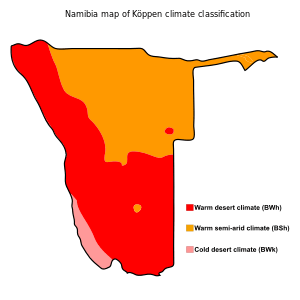
At 825,615 km2 (318,772 sq mi),[39] Namibia is the world's thirty-fourth largest country (after Venezuela). It lies mostly between latitudes 17° and 29°S (a small area is north of 17°), and longitudes 11° and 26°E.
Being situated between the Namib and the Kalahari deserts, Namibia has the least rainfall of any country in sub-Saharan Africa.[40]
The Namibian landscape consists generally of five geographical areas, each with characteristic abiotic conditions and vegetation, with some variation within and overlap between them: the Central Plateau, the Namib Desert, the Great Escarpment, the Bushveld, and the Kalahari Desert.
The Central Plateau runs from north to south, bordered by the Skeleton Coast to the northwest, the Namib Desert and its coastal plains to the southwest, the Orange River to the south, and the Kalahari Desert to the east. The Central Plateau is home to the highest point in Namibia at Königstein elevation 2,606 metres (8,550 ft).[41]
The Namib Desert is a broad expanse of hyper-arid gravel plains and dunes that stretches along Namibia's entire coastline. It varies between 100 and many hundreds of kilometres in width. Areas within the Namib include the Skeleton Coast and the Kaokoveld in the north and the extensive Namib Sand Sea along the central coast.[17]
The Great Escarpment swiftly rises to over 2,000 metres (6,562 ft). Average temperatures and temperature ranges increase further inland from the cold Atlantic waters, while the lingering coastal fogs slowly diminish. Although the area is rocky with poorly developed soils, it is significantly more productive than the Namib Desert. As summer winds are forced over the Escarpment, moisture is extracted as precipitation.[42]
The Bushveld is found in north-eastern Namibia along the Angolan border and in the Caprivi Strip. The area receives a significantly greater amount of precipitation than the rest of the country, averaging around 400 mm (15.7 in) per year. The area is generally flat and the soils sandy, limiting their ability to retain water and support agriculture.[43]
The Kalahari Desert, an arid region that extends into South Africa and Botswana, is one of Namibia's well-known geographical features. The Kalahari, while popularly known as a desert, has a variety of localised environments, including some verdant and technically non-desert areas. The Succulent Karoo is home to over 5,000 species of plants, nearly half of them endemic; approximately 10 percent of the world's succulents are found in the Karoo.[44] The reason behind this high productivity and endemism may be the relatively stable nature of precipitation.[45]
Namibia's Coastal Desert is one of the oldest deserts in the world. Its sand dunes, created by the strong onshore winds, are the highest in the world.[46] Because of the location of the shoreline, at the point where the Atlantic's cold water reaches Africa's hot climate, often extremely dense fog forms along the coast.[47] Near the coast there are areas where the dunes are vegetated with hammocks.[48] Namibia has rich coastal and marine resources that remain largely unexplored.[49]
Climate
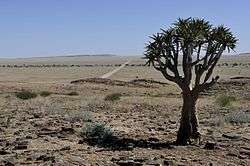
Namibia extends from 17°S to 25°S: climatically the range of the sub-Tropical High Pressure Belt. Its overall climate description is arid, descending from the Sub-Humid (mean rain above 500 mm) through Semi-Arid between 300 and 500 mm (embracing most of the waterless Kalahari) and Arid from 150 to 300 mm (these three regions are inland from the western escarpment) to the Hyper-Arid coastal plain with less than a 100 mm mean. Temperature maxima are limited by the overall elevation of the entire region: only in the far south, Warmbad for instance, are mid-40 °C maxima recorded.[50]
Typically the sub-Tropical High Pressure Belt, with frequent clear skies, provides more than 300 days of sunshine per year. It is situated at the southern edge of the tropics; the Tropic of Capricorn cuts the country about in half. The winter (June – August) is generally dry. Both rainy seasons occur in summer: the small rainy season between September and November, the big one between February and April.[51] Humidity is low, and average rainfall varies from almost zero in the coastal desert to more than 600 mm in the Caprivi Strip. Rainfall is highly variable, and droughts are common.[52] The last bad rainy season with rainfall far below the annual average occurred in summer 2006/07.[53]
Weather and climate in the coastal area are dominated by the cold, north-flowing Benguela current of the Atlantic Ocean, which accounts for very low precipitation (50 mm per year or less), frequent dense fog, and overall lower temperatures than in the rest of the country.[52] In Winter, occasionally a condition known as Bergwind (German for "mountain breeze") or Oosweer (Afrikaans for "east weather") occurs, a hot dry wind blowing from the inland to the coast. As the area behind the coast is a desert, these winds can develop into sand storms, leaving sand deposits in the Atlantic Ocean that are visible on satellite images.[54]
The Central Plateau and Kalahari areas have wide diurnal temperature ranges of up to 30 °C.[52]
Efundja, the annual seasonal flooding of the northern parts of the country, often causes not only damage to infrastructure but loss of life.[55] The rains that cause these floods originate in Angola, flow into Namibia's Cuvelai basin, and fill the oshanas (Oshiwambo: flood plains) there. The worst floods so far occurred in March 2011 and displaced 21,000 people.[56]
Water sources
Namibia is the driest country in sub-Saharan Africa and depends largely on groundwater. With an average rainfall of about 350 mm per annum, the highest rainfall occurs in the Caprivi in the northeast (about 600 mm per annum) and decreases in a westerly and southwesterly direction to as little as 50 mm and less per annum at the coast. The only perennial rivers are found on the national borders with South Africa, Angola, Zambia, and the short border with Botswana in the Caprivi. In the interior of the country, surface water is available only in the summer months when rivers are in flood after exceptional rainfalls. Otherwise, surface water is restricted to a few large storage dams retaining and damming up these seasonal floods and their runoff. Where people do not live near perennial rivers or make use of the storage dams, they are dependent on groundwater. Even isolated communities and those economic activities located far from good surface water sources, such as mining, agriculture, and tourism, can be supplied from groundwater over nearly 80% of the country.[57]
More than 100,000 boreholes have been drilled in Namibia over the past century. One third of these boreholes have been drilled dry.[58]
Communal Wildlife Conservancies

Namibia is one of few countries in the world to specifically address conservation and protection of natural resources in its constitution.[59] Article 95 states, "The State shall actively promote and maintain the welfare of the people by adopting international policies aimed at the following: maintenance of ecosystems, essential ecological processes, and biological diversity of Namibia, and utilisation of living natural resources on a sustainable basis for the benefit of all Namibians, both present and future."[59]
In 1993, the newly formed government of Namibia received funding from the United States Agency for International Development (USAID) through its Living in a Finite Environment (LIFE) Project.[60] The Ministry of Environment and Tourism, with the financial support from organisations such as USAID, Endangered Wildlife Trust, WWF, and Canadian Ambassador's Fund, together form a Community Based Natural Resource Management (CBNRM) support structure. The main goal of this project is promote sustainable natural resource management by giving local communities rights to wildlife management and tourism.[61]
Politics and government
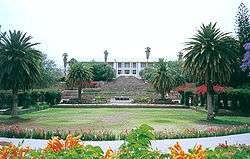
Namibia is a unitary semi-presidential representative democratic republic.[9][10] The President of Namibia is elected to a five-year term and is both the head of state and the head of government.[62] However, while the President is both head of state and government, all members of the government are individually and collectively responsible to the legislature.[63]
The Constitution of Namibia guarantees the separation of powers:[64]
- Executive: Executive power is exercised by the President and the Government.
- Legislature: Namibia has a bicameral Parliament with the National Assembly as lower house, and the National Council as the upper house.
- Judiciary: Namibia has a system of courts that interpret and apply the law in the name of the state.
While the constitution envisaged a multi-party system for Namibia's government, the SWAPO party has been dominant since independence in 1990.[65]
Foreign relations
Namibia follows a largely independent foreign policy, with persisting affiliations with states that aided the independence struggle, including Cuba. With a small army and a fragile economy, the Namibian Government's principal foreign policy concern is developing strengthened ties within the Southern African region. A dynamic member of the Southern African Development Community, Namibia is a vocal advocate for greater regional integration. Namibia became the 160th member of the UN on 23 April 1990. On its independence it became the fiftieth member of the Commonwealth of Nations.[66]
Military
Namibia does not have any enemies in the region but consistently spends more as a percentage of GDP on its military than all of its neighbours, except Angola. Military expenditure rose from 2.7% of GDP in 2000 to 3.7% in 2009, and the arrival of 12 Chengdu J-7 Airguard jets in 2006 and 2008 made Namibia for a short time one of the top arms importers in Sub-Saharan Africa.[67] By 2015, military expenditure was estimated at between 4% and 5% of GDP.[68][69][70]
The constitution of Namibia defined the role of the military as "defending the territory and national interests." Namibia formed the Namibian Defence Force (NDF), comprising former enemies in a 23-year bush war: the People's Liberation Army of Namibia (PLAN) and South West African Territorial Force (SWATF). The British formulated the plan for integrating these forces and began training the NDF, which consists of a small headquarters and five battalions.
The United Nations Transitional Assistance Group (UNTAG)'s Kenyan infantry battalion remained in Namibia for three months after independence to help train the NDF and to stabilise the north. According to the Namibian Defence Ministry, enlistments of both men and women will number no more than 7,500.
Administrative division
Namibia is divided into 15 regions and subdivided into 121 constituencies. The administrative division of Namibia is tabled by Delimitation Commissions and accepted or declined by the National Assembly. Since state foundation four Delimitation Commissions have delivered their work, the last one in 2013 under the chairmanship of Judge Alfred Siboleka.[71]
Regional councillors are directly elected through secret ballots (regional elections) by the inhabitants of their constituencies.[72]
Local authorities in Namibia can be in the form of municipalities (either Part 1 or Part 2 municipalities), town councils or villages.[73]
Economy
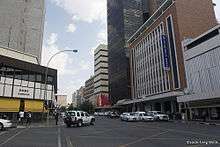
Namibia's economy is tied closely to South Africa's due to their shared history.[74][75] The largest economic sectors are mining (10.4% of the gross domestic product in 2009), agriculture (5.0%), manufacturing (13.5%), and tourism.[76]
Namibia has a highly developed banking sector with modern infrastructure, such as online banking and cellphone banking. The Bank of Namibia (BoN) is the central bank of Namibia responsible for performing all other functions ordinarily performed by a central bank. There are four BoN authorised commercial banks in Namibia: Bank Windhoek, First National Bank, Nedbank and Standard Bank.[77]
According to the Namibia Labour Force Survey Report 2012, conducted by the Namibia Statistics Agency, the country's unemployment rate is 27.4%.[78] "Strict unemployment" (people actively seeking a full-time job) stood at 20.2% in 2000, 21.9% in 2004 and spiraled to 29.4% in 2008. Under a broader definition (including people that have given up searching for employment) unemployment rose to 36.7% in 2004. This estimate considers people in the informal economy as employed. Labour and Social Welfare Minister Immanuel Ngatjizeko praised the 2008 study as "by far superior in scope and quality to any that has been available previously",[79] but its methodology has also received criticism.[80]
In 2004 a labour act was passed to protect people from job discrimination stemming from pregnancy and HIV/AIDS status. In early 2010 the Government tender board announced that "henceforth 100 per cent of all unskilled and semi-skilled labour must be sourced, without exception, from within Namibia".[81]
In 2013, global business and financial news provider, Bloomberg, named Namibia the top emerging market economy in Africa and the 13th best in the world. Only four African countries made the Top 20 Emerging Markets list in the March 2013 issue of Bloomberg Markets magazine, and Namibia was rated ahead of Morocco (19th), South Africa (15th) and Zambia (14th). Worldwide, Namibia also fared better than Hungary, Brazil and Mexico. Bloomberg Markets magazine ranked the top 20 based on more than a dozen criteria. The data came from Bloomberg's own financial-market statistics, IMF forecasts and the World Bank. The countries were also rated on areas of particular interest to foreign investors: the ease of doing business, the perceived level of corruption and economic freedom. In order to attract foreign investment, the government has made improvement in reducing red tape resulted from excessive government regulations making the country one of the least bureaucratic places to do business in the region. However, facilitation payments are occasionally demanded by customs due to cumbersome and costly customs procedures.[82] Namibia is also classified as an Upper Middle Income country by the World Bank, and ranks 87th out of 185 economies in terms of ease of doing business.[83]
The cost of living in Namibia is relatively high because most of the goods including cereals need to be imported. Business monopoly in some sectors causes higher profit bookings and further raising of prices. Its capital city, Windhoek is currently ranked as the 150th most expensive place in the world for expatriates to live.[84]
Taxation in Namibia includes personal income tax, which is applicable to total taxable income of an individual and all individuals are taxed at progressive marginal rates over a series of income brackets. The value added tax (VAT) is applicable to most of the commodities and services.[85]
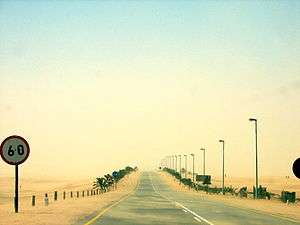
Despite the remote nature of much of the country, Namibia has seaports, airports, highways, and railways (narrow-gauge). The country seeks to become a regional transportation hub; it has an important seaport and several landlocked neighbours. The Central Plateau already serves as a transportation corridor from the more densely populated north to South Africa, the source of four-fifths of Namibia's imports.[86]
Agriculture
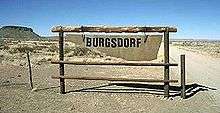
About half of the population depends on agriculture (largely subsistence agriculture) for its livelihood, but Namibia must still import some of its food. Although per capita GDP is five times the per capita GDP of Africa's poorest countries, the majority of Namibia's people live in rural areas and exist on a subsistence way of life. Namibia has one of the highest rates of income inequality in the world, due in part to the fact that there is an urban economy and a more rural cash-less economy. The inequality figures thus take into account people who do not actually rely on the formal economy for their survival. Although arable land accounts for only 1% of Namibia, nearly half of the population is employed in agriculture.[86]
About 4,000, mostly white, commercial farmers own almost half of Namibia's arable land.[87] The governments of Germany and Britain will finance Namibia's land reform process, as Namibia plans to start expropriating land from white farmers to resettle landless black Namibians.[88]
Agreement has been reached on the privatisation of several more enterprises in coming years, with hopes that this will stimulate much needed foreign investment. However, reinvestment of environmentally derived capital has hobbled Namibian per capita income.[89] One of the fastest growing areas of economic development in Namibia is the growth of wildlife conservancies. These conservancies are particularly important to the rural, generally unemployed, population.
An aquifer called "Ohangwena II" has been discovered, capable of supplying the 800,000 people in the North for 400 years.[90] Experts estimate that Namibia has 7720 km3 of underground water.[91][92]
Mining and electricity
Providing 25% of Namibia's revenue, mining is the single most important contributor to the economy.[93] Namibia is the fourth largest exporter of non-fuel minerals in Africa and the world's fourth largest producer of uranium. There has been significant investment in uranium mining and Namibia is set to become the largest exporter of uranium by 2015.[94] Rich alluvial diamond deposits make Namibia a primary source for gem-quality diamonds.[95] While Namibia is known predominantly for its gem diamond and uranium deposits, a number of other minerals are extracted industrially such as lead, tungsten, gold, tin, fluorspar, manganese, marble, copper and zinc. There are offshore gas deposits in the Atlantic Ocean that are planned to be extracted in the future.[76] According to "The Diamond Investigation", a book about the global diamond market, from 1978, De Beers, the largest diamond company, bought most of the Namibian diamonds, and would continue to do so, because "whatever government eventually comes to power they will need this revenue to survive".[96]
Domestic supply voltage is 220V AC. Electricity is generated mainly by thermal and hydroelectric power plants. Non-conventional methods of electricity generation also play some role. Encouraged by the rich uranium deposits the Namibian government plans to erect its first nuclear power station by 2018, also uranium enrichment is envisaged to happen locally.[97]
Tourism
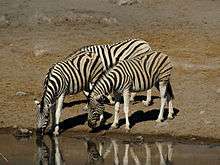
Tourism is a major contributor (14.5%) to Namibia's GDP, creating tens of thousands of jobs (18.2% of all employment) directly or indirectly and servicing over a million tourists per year.[98] The country is a prime destination in Africa and is known for ecotourism which features Namibia's extensive wildlife.[99]
There are many lodges and reserves to accommodate eco-tourists. Sport hunting is also a large, and growing component of the Namibian economy, accounting for 14% of total tourism in the year 2000, or $19.6 million US dollars, with Namibia boasting numerous species sought after by international sport hunters.[100] In addition, extreme sports such as sandboarding, skydiving and 4x4ing have become popular, and many cities have companies that provide tours. The most visited places include the capital city of Windhoek, Caprivi Strip, Fish River Canyon, Sossusvlei, the Skeleton Coast Park, Sesriem, Etosha Pan and the coastal towns of Swakopmund, Walvis Bay and Lüderitz.[101]
The capital city of Windhoek plays a very important role in Namibia's tourism due to its central location and close proximity to Hosea Kutako International Airport. According to The Namibia Tourism Exit Survey, which was produced by the Millennium Challenge Corporation for the Namibian Directorate of Tourism, 56% of all tourists visiting Namibia during the time period, 2012 – 2013, visited Windhoek.[102] Many of Namibia's tourism related parastatals and governing bodies such as Namibia Wildlife Resorts, Air Namibia and the Namibia Tourism Board as well as Namibia's tourism related trade associations such as the Hospitality Association of Namibia are also all headquartered in Windhoek.[103] There are also a number of notable hotels in Windhoek such as Windhoek Country Club Resort and some international hotel chains also operate in Windhoek, such as Avani Hotels and Resorts and Hilton Hotels and Resorts.
Namibia's primary tourism related governing body, the Namibia Tourism Board (NTB), was established by an Act of Parliament: the Namibia Tourism Board Act, 2000 (Act 21 of 2000). Its primary objectives are to regulate the tourism industry and to market Namibia as a tourist destination.[104] There are also a number of trade associations that represent the tourism sector in Namibia, such as the Federation of Namibia Tourism Associations (the umbrella body for all tourism associations in Namibia), the Hospitality Association of Namibia, the Association of Namibian Travel Agents, Car Rental Association of Namibia and the Tour and Safari Association of Namibia.[105]
Water supply and sanitation
Namibia is the only country in Sub-Saharan Africa to provide water through municipal departments.[106] The only bulk water supplier in Namibia is NamWater, which sells it to the respective municipalities which in turn deliver it through their reticulation networks.[106] In rural areas, the Directorate of Rural Water Supply in the Ministry of Agriculture, Water and Forestry is in charge of drinking water supply.[106]
The UN evaluated in 2011 that Namibia has improved its water access network significantly since independence in 1990. A large part of the population can not, however, make use of these resources due to the prohibitively high consumption cost and the long distance between residences and water points in rural areas.[106] As a result, many Namibians prefer the traditional wells over the available water points far away.[107]
Compared to the efforts made to improve access to safe water, Namibia is lagging behind in the provision of adequate sanitation.[108] This includes 298 schools that have no toilet facilities.[109] Over 50% of child deaths are related to lack of water, sanitation, or hygiene; 23% are due to diarrhea alone. The UN has identified a "sanitation crisis" in the country.[107]
Apart from residences for upper and middle class households, sanitation is insufficient in most residential areas. Private flush toilets are too expensive for virtually all residents in townships due to their water consumption and installation cost. As a result, access to improved sanitation has not increased much since independence: In Namibia's rural areas 13% of the population had more than basic sanitation, up from 8% in 1990. Many of Namibia's inhabitants have to resort to "flying toilets", plastic bags to defecate which after use are flung into the bush.[110] The use of open areas close to residential land to urinate and defecate is very common[111] and has been identified as a major health hazard.[109]
Demographics
.jpg)
.jpg)
Namibia has the second-lowest population density of any sovereign country, after Mongolia.[112] The majority of the Namibian population is of Bantu-speaking origin – mostly of the Ovambo ethnicity, which forms about half of the population – residing mainly in the north of the country, although many are now resident in towns throughout Namibia. Other ethnic groups are the Herero and Himba people, who speak a similar language, and the Damara, who speak the same "click" language as the Nama.
In addition to the Bantu majority, there are large groups of Khoisan (such as Nama and San), who are descendants of the original inhabitants of Southern Africa. The country also contains some descendants of refugees from Angola. There are also two smaller groups of people with mixed racial origins, called "Coloureds" and "Basters", who together make up 8.0% (with the Coloureds outnumbering the Basters two to one). There is a large Chinese minority in Namibia.[113]
Whites (mainly of Afrikaner, German, British and Portuguese origin) make up between 4.0 and 7.0% of the population. Although their percentage of population is decreasing due to emigration and lower birth rates they still form the second-largest population of European ancestry, both in terms of percentage and actual numbers, in Sub-Saharan Africa (after South Africa).[114] The majority of Namibian whites and nearly all those who are mixed race speak Afrikaans and share similar origins, culture, and religion as the white and coloured populations of South Africa. A large minority of whites (around 30,000) trace their family origins back to the German settlers who colonized Namibia prior to the British confiscation of German lands after World War One, and they maintain German cultural and educational institutions. Nearly all Portuguese settlers came to the country from the former Portuguese colony of Angola.[115] The 1960 census reported 526,004 persons in what was then South-West Africa, including 73,464 whites (14%).[116]
Namibia conducts a census every ten years. After independence the first Population and Housing Census was carried out in 1991, further rounds followed in 2001 and 2011.[117] The data collection method is to count every person resident in Namibia on the census reference night, wherever they happen to be. This is called the de facto method.[118] For enumeration purposes the country is demarcated into 4,042 enumeration areas. These areas do not overlap with constituency boundaries to get reliable data for election purposes as well.[119]
The 2011 Population and Housing Census counted 2,113,077 inhabitants of Namibia. Between 2001 and 2011 the annual population growth was 1.4%, down from 2.6% in the previous ten–year period.[120]
Religion
The Christian community makes up 80%–90% of the population of Namibia, with at least 75% being Protestant, and at least 50% Lutheran. It is the largest religious group – a legacy of the German and Finnish missionary work during the country's colonial times. 10%–20% of the population hold indigenous beliefs.[114]
Missionary activities during the second half of the 19th century resulted in many Namibians converting to Christianity. Today most Christians are Lutheran, but there also are Roman Catholic, Methodist, Anglican, African Methodist Episcopal, Dutch Reformed and Mormons (the Church of Jesus Christ of Latter-Day Saints).
Namibia is home to a small Jewish community of about 100 members.[121]
Language
Up to 1990, English, German and Afrikaans were official languages. Long before Namibia's independence from South Africa, SWAPO was of the opinion that the country should become officially monolingual, choosing this approach in contrast to that of its neighbour South Africa (which granted all 11 of its major languages official status), which was seen by them as "a deliberate policy of ethnolinguistic fragmentation."[122] Consequently, SWAPO instituted English as the sole official language of Namibia though only about 3% of the population speaks it as a home language. Its implementation is focused on the civil service, education and the broadcasting system.[123] Some other languages have received semi-official recognition by being allowed as medium of instruction in primary schools. It is expected of private schools to follow the same policy as state schools, and "English language" is a compulsory subject.[123] As in other postcolonial African societies, the push for monolingual instruction and policy has resulted in a high rate of school drop-outs and of individuals whose academic competence in any language is low.[124]
According to the 2011 census, the most common languages are Oshiwambo (the most spoken language for 49% of households), Nama/Damara (11.3%), Afrikaans (10.4%), Kavango (9%), Otjiherero (9%).[120][125] The most widely understood and spoken language is English. Both Afrikaans and English are used primarily as a second language reserved for public communication.
Most of the white population speaks either German or Afrikaans. Even today, 101 years after the end of the German colonial era, the German language plays a role as a commercial language. Afrikaans is spoken by 60% of the white community, German is spoken by 32%, English is spoken by 7% and Portuguese by 1%.[114] Geographical proximity to Portuguese-speaking Angola explains the relatively high number of Portuguese speakers; in 2011 these were estimated to be 100,000, or 4–5% of the total population.[126]
Largest cities
| | |||||||||
|---|---|---|---|---|---|---|---|---|---|
| Rank | Name | Region | Pop. | ||||||
 Windhoek 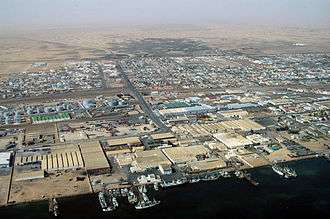 Walvis Bay |
1 | Windhoek | Khomas | 322,500 | 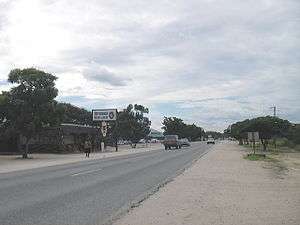 Rundu .jpg) Swakopmund | ||||
| 2 | Walvis Bay | Erongo | 85,000 | ||||||
| 3 | Rundu | Kavango | 63,431 | ||||||
| 4 | Swakopmund | Erongo | 44,725 | ||||||
| 5 | Oshakati | Oshana | 36,540 | ||||||
| 6 | Rehoboth | Hardap | 28,843 | ||||||
| 7 | Katima Mulilo | Zambezi | 28,362 | ||||||
| 8 | Otjiwarongo | Otjozondjupa | 28,249 | ||||||
| 9 | Ondangwa | Oshana | 22,822 | ||||||
| 10 | Okahandja | Otjozondjupa | 22,639 | ||||||
Sport
The most popular sport in Namibia is association football. The Namibia national football team qualified for the 2008 Africa Cup of Nations but has yet to qualify for any World Cups.
The most successful national team is the Namibian rugby team, having competed in five separate World Cups. Namibia were participants in the 1999, 2003, 2007, 2011 and 2015 Rugby World Cups. Cricket is also popular, with the national side having played in the 2003 Cricket World Cup. Netball is popular as well.
Inline hockey was first played in 1995 and has also become more and more popular in the last years. The Women's inline hockey National Team participated in the 2008 FIRS World Championships. Namibia is the home for one of the toughest footraces in the world, the Namibian ultra marathon. The most famous athlete from Namibia is Frankie Fredericks, sprinter (100 and 200 m). He won four Olympic silver medals (1992, 1996) and also has medals from several World Athletics Championships. He is also known for humanitarian activities in Namibia and beyond.
Golfer Trevor Dodds won on the PGA Tour in 1998 (The Greater Greensborough Open) and won 15 tournaments in his career. He achieved a career high world ranking of 78 in 1998.
The Swakopmund Skydiving Club in Swakopmund was founded in 1974, and operates still today from Swakopmund Airport.
Professional cyclist and Namibian Road Race Champion Dan Craven represented Namibia at the 2016 Summer Olympics in both the road race and individual time trial.
Media
Although Namibia's population is fairly small, the country has a diverse choice of media; two TV stations, 19 radio stations (without counting community stations), 5 daily newspapers, several weeklies and special publications compete for the attention of the audience. Additionally, a mentionable amount of foreign media, especially South African, is available. Online media are mostly based on print publication contents. Namibia has a state-owned Press Agency, called NAMPA.[127]
The first newspaper in Namibia was the German-language Windhoeker Anzeiger, founded 1898. Radio was introduced in 1969, TV in 1981. During German rule, the newspapers mainly reflected the living reality and the view of the white German-speaking minority. The black majority was ignored or depicted as a threat. During South African rule, the white bias continued, with mentionable influence of the Pretoria government on the "South West African" media system. Independent newspapers were seen as a menace to the existing order, critical journalists threatened.[127][128][129]
The daily newspapers include the private publications The Namibian (English and other languages), Die Republikein (Afrikaans), Allgemeine Zeitung (German) and Namibian Sun (English) as well as the state-owned New Era (predominantly English). Except for the largest newspaper, The Namibian, which is owned by a trust, the other mentioned private newspapers are part of the Democratic Media Holdings.[127]
Other mentionable newspapers are the tabloid Informanté owned by TrustCo, the weekly Windhoek Observer, the weekly Namibia Economist, as well as the regional Namib Times. Current affairs magazines include Insight Namibia, Vision2030 Focus magazine and Prime FOCUS. Sister Namibia Magazine stands out as the longest running NGO magazine in Namibia, while Namibia Sport is the only national sport magazine. Furthermore, the print market is complemented with party publications, student newspapers and PR publications.[127]
The broadcasting sector is dominated by the state-run Namibian Broadcasting Corporation (NBC). The public broadcaster offers a TV station as well as a "National Radio" in English and nine language services in locally spoken languages. The nine private radio stations in the country are mainly English-language channels, except for Radio Omulunga (Oshiwambo) and Kosmos 94.1 (Afrikaans). Privately held One Africa TV has competed with NBC since the 2000s.[127][130]
Compared to neighbouring countries, Namibia has a large degree of media freedom. Over the past years, the country usually ranked in the upper quarter of the Press Freedom Index of Reporters without Borders, reaching position 21 in 2010, being on par with Canada and the best-positioned African country.[131] The African Media Barometer shows similarly positive results. However, as in other countries, there is still mentionable influence of representatives of state and economy on media in Namibia.[127] In 2009, Namibia dropped to position 36 on the Press Freedom Index.[132] In 2013, it was 19th.[133] In 2014 it ranked 22nd [134]
Media and journalists in Namibia are represented by the Namibian chapter of the Media Institute of Southern Africa and the Editors' Forum of Namibia. An independent media ombudsman was appointed in 2009 to prevent a state-controlled media council.[127]
Education
Namibia has free education for both Primary and secondary education levels. Grades 1–7 are primary level, grades 8–12 secondary. In 1998, there were 400,325 Namibian students in primary school and 115,237 students in secondary schools. The pupil-teacher ratio in 1999 was estimated at 32:1, with about 8% of the GDP being spent on education.[135] Curriculum development, educational research, and professional development of teachers is centrally organised by the National Institute for Educational Development (NIED) in Okahandja.[136]
Most schools in Namibia are state-run, but there are quite a few private schools also part of the country's education system. There are four teacher training universities, three colleges of agriculture, a police training college, and two universities: University of Namibia (UNAM) and Namibia University of Science and Technology (NUST).
Health
Life expectancy at birth is estimated to be 52.2 years in 2012 – among the lowest in the world.[137] The AIDS epidemic is a large problem in Namibia. Though its rate of infection is substantially lower than that of its eastern neighbour, Botswana, approximately 13.1% of the adult population is infected with HIV.[138] In 2001, there were an estimated 210,000 people living with HIV/AIDS, and the estimated death toll in 2003 was 16,000. According to the 2011 UNAIDS Report, the epidemic in Namibia "appears to be leveling off."[139] As the HIV/AIDS epidemic has reduced the working-aged population, the number of orphans has increased. It falls to the government to provide education, food, shelter and clothing for these orphans.[140]
The malaria problem seems to be compounded by the AIDS epidemic. Research has shown that in Namibia the risk of contracting malaria is 14.5% greater if a person is also infected with HIV. The risk of death from malaria is also raised by approximately 50% with a concurrent HIV infection.[141] Given infection rates this large, as well as a looming malaria problem, it may be very difficult for the government to deal with both the medical and economic impacts of this epidemic. The country had only 598 physicians in 2002.[142]
See also
Lists
References
Footnotes
- ↑ "Communal Land Reform Act, Afrikaans" (PDF). Government of Namibia. Retrieved 18 February 2016.
- ↑ "Communal Land Reform Act, German" (PDF). Government of Namibia. Retrieved 18 February 2016.
- ↑ "Communal Land Reform Act, Khoekhoegowab" (PDF). Government of Namibia. Retrieved 18 February 2016.
- ↑ "Communal Land Reform Act, Otjiherero" (PDF). Government of Namibia. Retrieved 18 February 2016.
- ↑ "Communal Land Reform Act, Oshiwambo" (PDF). Government of Namibia. Retrieved 18 February 2016.
- ↑ "Communal Land Reform Act, Rukwangali" (PDF). Government of Namibia. Retrieved 18 February 2016.
- ↑ "Communal Land Reform Act, Setswana" (PDF). Government of Namibia. Retrieved 18 February 2016.
- ↑ "Communal Land Reform Act, Lozi" (PDF). Government of Namibia. Retrieved 18 February 2016.
- 1 2 Shugart, Matthew Søberg (September 2005). "Semi-Presidential Systems: Dual Executive and Mixed Authority Patterns" (PDF). Graduate School of International Relations and Pacific Studies. United States: University of California, San Diego. Archived from the original (PDF) on 19 August 2008. Retrieved 4 September 2016.
- 1 2 Shugart, Matthew Søberg (December 2005). "Semi-Presidential Systems: Dual Executive And Mixed Authority Patterns" (PDF). French Politics. Palgrave Macmillan Journals. 3 (3): pp. 323–351. doi:10.1057/palgrave.fp.8200087. Retrieved 4 September 2016.
Of the contemporary cases, only four provide the assembly majority an unrestricted right to vote no confidence, and of these, only two allow the president unrestricted authority to appoint the prime minister. These two, Mozambique and Namibia, as well as the Weimar Republic, thus resemble most closely the structure of authority depicted in the right panel of Figure 3, whereby the dual accountability of the cabinet to both the president and the assembly is maximized. (...) Namibia allows the president to dissolve [the assembly] at any time but places a novel negative incentive on his exercise of the right: He must stand for a new election at the same time as the new assembly elections.
- ↑ "GeoHive – Namibia population". GeoHive. Retrieved 12 December 2013.
- 1 2 3 4 "Namibia". International Monetary Fund.
- ↑ "Economic Policy and Poverty Unit". UNDP Namibia. Retrieved 10 September 2013.
- ↑ "2015 Human Development Report" (PDF). United Nations Development Programme. 2015. Retrieved 15 December 2015.
- ↑ Wells, John C. (2008), Longman Pronunciation Dictionary (3rd ed.), Longman, ISBN 9781405881180
- ↑ Roach, Peter (2011), Cambridge English Pronouncing Dictionary (18th ed.), Cambridge: Cambridge University Press, ISBN 9780521152532
- 1 2 Spriggs, A. (2001) "Africa: Namibia". Terrestrial Ecoregions. World Wildlife Fund.
- ↑ Dierks, Klaus. "Biographies of Namibian Personalities, A". Archived from the original on 15 October 2008. Retrieved 24 June 2010.
- ↑ Dierks, Klaus. "Warmbad becomes two hundred years". Retrieved 22 June 2010.
- ↑ Vedder 1997, p. 177.
- ↑ Vedder 1997, p. 659.
- ↑ "German South West Africa". Encyclopædia Britannica. Retrieved 15 April 2008.
- ↑ David Olusoga. "Dear Pope Francis, Namibia was the 20th century's first genocide | David Olusoga | Comment is free". The Guardian. Retrieved 26 November 2015.
- ↑ Drechsler, Horst (1980). The actual number of deaths in the limited number of battles with the Germany Schutztruppe (expeditionary force) were limited; most of the deaths occurred after fighting had ended. The German military governor Lotha von Trotha issued an explicit extermination order, and many Herero died of disease and abuse in detention camps after being taken from their land. A substantial minority of Herero crossed the Kalahari desert into the British colony of Bechuanaland (modern-day Botswana), where a small community continues to live in western Botswana near to border with Namibia. Let us die fighting, originally published (1966) under the title Südwestafrika unter deutsche Kolonialherrschaft. Berlin: Akademie-Verlag.
- ↑ Adhikari, Mohamed (2008). "'Streams of Blood And Streams of Money': New Perspectives on the Annihilation of the Herero and Nama Peoples of Namibia, 1904–1908". Kronos. 34: 303–320. JSTOR 41056613.
- ↑ Madley, Benjamin (2005). "From Africa to Auschwitz: How German South West Africa Incubated Ideas and Methods Adopted and Developed by the Nazis in Eastern Europe". European History Quarterly. 35 (3): 429–464. doi:10.1177/0265691405054218. says it influenced Nazis.
- ↑ Reinhart Kössler, and Henning Melber, "Völkermord und Gedenken: Der Genozid an den Herero und Nama in Deutsch-Südwestafrika 1904–1908," ("Genocide and memory: the genocide of the Herero and Nama in German South-West Africa, 1904–08") Jahrbuch zur Geschichte und Wirkung des Holocaust 2004: 37–75
- ↑ Andrew Meldrum in Pretoria. "German apology for Namibia genocide | World news". The Guardian. Retrieved 26 November 2015.
- ↑ "Namibian War of Independence 1966–1988". Armed Conflict Events Database. Retrieved 30 November 2009.
- ↑ Petronella Sibeene (17 April 2009). "Swapo Party Turns 49". New Era.
- ↑ "Klaus Dierks Chronology of Namibian History, 1977". Klausdierks.com. 19 August 1977. Retrieved 10 September 2013.
- ↑ Tapscott, Chris (January 1994). "Land reform in Namibia: Why not?". Southern African Report. 9 (3): 12. Archived from the original on 24 December 2010.
- ↑ Legal Repertory of Practice of United Nations Organs
- ↑ Udogu, E. Ike (2012). Liberating Namibia. Jefferson, NC: McFarland & Co. p. 158.
- ↑ "Chronology of Namibian Independence". Klausdierks.com. Retrieved 26 June 2010.
- ↑ "Treaty between the Government of the Republic of South Africa and the Government of the Republic of Namibia with respect to Walvis Bay and the off-shore Islands, 28 February 1994" (PDF). United Nations.
- ↑ "Country report: Spotlight on Namibia". Commonwealth Secretariat. 25 May 2010. Archived from the original on 5 July 2010.
- 1 2 "IRIN country profile Namibia". IRIN. March 2007. Archived from the original on 17 February 2010. Retrieved 12 July 2010.
- ↑ "Rank Order – Area". CIA World Fact Book. Retrieved 12 April 2008.
- ↑ Brandt, Edgar (21 September 2012). "Land degradation causes poverty". New Era.
- ↑ "Landsat.usgs.gov". Landsat.usgs.gov. Retrieved 26 June 2010.
- ↑ Spriggs, A. (2001) "Africa: Namibia". Terrestrial Ecoregions. World Wildlife Fund.
- ↑ Cowling, S. 2001. "Succulent Karoo". Terrestrial Ecoregions. World Wildlife Fund.
- ↑ van Jaarsveld 1987, Smith et al 1993
- ↑ Spriggs, A. (2001) "Southern Africa: including parts of Botswana, northeastern Namibia, Zimbabwe, and northern South Africa". Terrestrial Ecoregions. World Wildlife Fund.
- ↑ "NASA – Namibia's Coastal Desert". nasa.gov. Retrieved 9 October 2009.
- ↑ "An Introduction to Namibia". geographia.com. Retrieved 9 October 2009.
- ↑ "NACOMA – Namibian Coast Conservation and Management Project". nacoma.org.na. Retrieved 9 October 2009.
- ↑ Sparks, Donald L. "Namibia's Coastal and Marine Development Potential". African Affairs. 83 (333): 477.
- ↑ "Paper and digital Climate Section". Namibia Meteorological Services
- ↑ "The Rainy Season". Real Namibia. Retrieved 28 July 2010.
- 1 2 3 "Namibia". Encyclopædia Britannica. Retrieved 28 July 2010.
- ↑ Olszewski, John (13 May 2009). "Climate change forces us to recognise new normals". Namibia Economist. Archived from the original on 13 May 2011.
- ↑ Olszewski, John (25 June 2010). "Understanding Weather – not predicting it". Namibia Economist. Archived from the original on 7 December 2010.
- ↑ Adams, Gerry (15 April 2011). "Debilitating floods hit northern and central Namibia". United Nations Radio.
- ↑ van den Bosch, Servaas (29 March 2011). "Heaviest floods ever in Namibia". The Namibian.
- ↑ Groundwater in Namibia. iwrm-namibia.info.na
- ↑ Downloads. Namibian Hydrogeological Association
- 1 2 Stefanova, Kristina (August 2005). Protecting Namibia’s Natural Resources. usinfo.state.gov
- ↑ Community Based Natural Resource Management (CBNRM) Programme Details (n.d.).
- ↑ Nature in Local Hands: The Case for Namibia's Conservancies. UNEP, UNDP, WRI, and World Bank. 2005.
- ↑ Namibia: Constitution. eisa.org.za. Updated July 2005 Archived 4 June 2012 at the Wayback Machine.
- ↑ Article 41 of the Constitution of the Republic of Namibia
- ↑ Shivute, Peter (2008). "Foreword". In Bösl, Anton; Horn, Nico. The Independence of the Judiciary in Namibia (PDF). Publications sponsored by Konrad Adenauer Stiftung. Macmillan Education Namibia. p. 10. ISBN 978-99916-0-807-5.
- ↑ "SWAPO:Dominant party?". Swapoparty.org.
- ↑ "Africa and the CON". Africanhistory.about.com.
- ↑ Hopwood, Graham (February 2012). "Flying high". insight Namibia.
- ↑ Insight 2015, p.33
- ↑ defenceWeb (16 April 2015). "Further spending for Namibian military". defenceweb.co.za. Retrieved 13 October 2015.
- ↑ "Namibia Economy Profile 2014". Indexmundi.com. Retrieved 26 November 2015.
- ↑ Nakale, Albertina Haindongo (9 August 2013). "President divides Kavango into two". New Era. via allafrica.com. Archived from the original on 21 December 2015.
- ↑ "Namibia National Council". Inter-Parliamentary Union. Retrieved 14 July 2010.
- ↑ "Local Authorities". Association of Local Authorities in Namibia. Retrieved 10 September 2013.
- ↑ "Namibia". The World Factbook. Central Intelligence Agency.
- ↑ "Namibia". UCB Libraries GovPubs.
- 1 2 "Background Note:Namibia". US Department of State. 26 October 2010.
- ↑ "Bank of Namibia (BoN)". Retrieved 3 April 2011.
- ↑ Namibia Labour Force Survey Report 2012. nsa.org.na
- ↑ Duddy, Jo-Mare (4 February 2010) "Half of all Namibians unemployed". The Namibian
- ↑ Ndjebela, Toivo (18 November 2011). "Mwinga speaks out on his findings". New Era.
- ↑ Mongudhi, Tileni (3 February 2010 ) "Tender Board tightens rules to protect jobs". The Namibian
- ↑ "Snapshot of Namibia Country Profile". Business Anti-Corruption Portal. Retrieved 6 February 2014.
- ↑ "Namibia". Doingbusiness.org. 10 January 2013. Retrieved 10 September 2013.
- ↑ "Namibia, Windhoek Cost of Living".
- ↑ PAYE12 Volume 18 published by The Ministry of Finance in Namibia
- 1 2 World Almanac. 2004.
- ↑ LaFraniere, Sharon (25 December 2004) Tensions Simmer as Namibia Divides Its Farmland", The New York Times
- ↑ "NAMIBIA: Key step in land reform completed". IRIN Africa. 1 October 2004. Retrieved 10 September 2013.
- ↑ Lange, Glenn-marie (2004). "Wealth, Natural Capital, and Sustainable Development: Contrasting Examples from Botswana and Namibia". Environmental & Resource Economics. 29 (3): 257–83. doi:10.1007/s10640-004-4045-z.
- ↑ McGrath, Matt (20 July 2012). "Vast aquifer found in Namibia could last for centuries". BBC World. Retrieved 10 September 2013.
- ↑ McGrath, Matt (20 April 2012). "'Huge' water resource exists under Africa". BBC World Service. Retrieved 10 September 2013.
- ↑ MacDonald AM, Bonsor HC, Dochartaigh B, Taylor RG (2012). "Quantitative maps of groundwater resources in Africa". Environ. Res. Lett. 7 (2): 024009. doi:10.1088/1748-9326/7/2/024009.
- ↑ "Mining in Namibia" (PDF). NIED. Retrieved 26 June 2010.
- ↑ Oancea, Dan (February 2008). "Mining Uranium at Namibia's Langer Heinrich Mine" (PDF). MINING.com.
- ↑ Oancea, Dan (6 November 2006). "Deep-Sea Mining and Exploration". Technology.infomine.com.
- ↑ "The Diamond Investigation, chapter 1 by Edward Jay Epstein, in an interview with Harry Frederick Oppenheimer owner of De Beers". Edwardjayepstein.com. 4 December 1978. Retrieved 10 September 2013.
- ↑ Weidlich, Brigitte (7 January 2011). "Uranium: Saving or sinking Namibia?". The Namibian. Archived from the original on 13 January 2011.
- ↑ "A Framework/Model to Benchmark Tourism GDP in South Africa". Pan African Research & Investment Services. March 2010. p. 34. Archived from the original on 18 July 2010.
- ↑ Hartman, Adam (30 September 2009). "Tourism in good shape – Minister". The Namibian.
- ↑ Humavindu, Michael N., Barnes, Jonothan I (October 2003). "Trophy Hunting in the Namibian Economy: An Assessment. Environmental Economics Unit, Directorate of Environmental Affairs, Ministry of Environment and Tourism, Namibia". South African Journal of Wildlife Research. 33 (2): 65–70.
- ↑ "Namibia top tourist destinations". Namibiatourism.com.na.
- ↑ http://www.mcanamibia.org/files/files/exitsurvey.pdf
- ↑ "HAN Namibia".
- ↑ http://www.saflii.org/na/other/NAGovGaz/2004/114.pdf
- ↑ "FENATA | Federation of Namibian Tourism Association in Namibia". www.fenata.org. Retrieved 2016-03-08.
- 1 2 3 4 Banerjee, Sudeshna (2009). Ebbing Water, Surging Deficits: Urban Water Supply in Sub-Saharan Africa (PDF). Washington, DC: The International Bank for Reconstruction and Development / The World Bank.
- 1 2 Smith, Jana–Mari (12 July 2011). "Red alert on sanitation and safe drinking water". The Namibian.
- ↑ "Independent UN expert urges Namibia to expand access to sanitation services". UN News Centre. United Nations News service. 11 July 2011.
- 1 2 Tjihenuna, Theresia (2 April 2014). "More than 1 million Namibians defecate in open". The Namibian.
- ↑ Cloete, Luqman (28 April 2008). "Namibia is lagging behind on sanitation". The Namibian.
- ↑ Deffner, Jutta; Mazambani, Clarence (September 2010). "Participatory empirical research on water and sanitation demand in central northern Namibia: A method for technology development with a user perspective" (PDF). CuveWaters Papers. Frankfurt (Main): Institute for Social-Ecological Research (ISOE). 7.
- ↑ Department of Economic and Social Affairs Population Division (2009). "World Population Prospects, Table A.1" (PDF). 2008 revision. United Nations. Retrieved 12 March 2009.
- ↑ Malia Politzer (August 2008). "China and Africa: Stronger Economic Ties Mean More Migration". Migration Information Source. Retrieved 10 September 2013.
- 1 2 3 Central Intelligence Agency (2009). "Namibia". The World Factbook. Retrieved 23 January 2010.
- ↑ "Flight from Angola". The Economist. 16 August 1975. Retrieved 10 September 2013.
- ↑ Singh, Lalita Prasad (1980). The United Nations and Namibia. East African Publishing House.
- ↑ "Census Summary Results". National Planning Commission of Namibia. Retrieved 21 February 2012.
- ↑ Kapitako, Alvine (8 August 2011). "Namibia: 2011 Census Officially Launched". New Era. via allafrica.com.
- ↑ "Methodology". National Planning Commission of Namibia. Retrieved 21 February 2012.
- 1 2 Duddy, Jo Maré (28 March 2013). "Census gives snapshot of Namibia's population". The Namibian.
- ↑ "Namibia: Virtual Jewish History Tour". Jewishvirtuallibrary.org. Retrieved 1 August 2013.
- ↑ Pütz, Martin (1995) "Official Monolingualism in Africa: A sociolinguistic assessment of linguistic and cultural pluralism in Africa", p. 155 in Discrimination through language in Africa? Perspectives on the Namibian Experience. Mouton de Gruyter. Berlin, ISBN 311014817X
- 1 2 Kriger, Robert & Ethel (1996). Afrikaans Literature: Recollection, Redefinition, Restitution. Rodopi Bv Editions. pp. 66–67. ISBN 9042000511.
- ↑ Tötemeyer, Andree-Jeanne. Multilingualism and the language policy for Namibian schools. PRAESA Occasional Papers No. 37. University of Cape Town. Cape Town:2010.
- ↑ "Namibia 2011 – Population and Housing Census Main Report" (PDF). Namibia Statistics Agency. Retrieved 10 September 2013.
- ↑ Sasman, Catherine (15 August 2011). "Portuguese to be introduced in schools". The Namibian. Retrieved 24 June 2012.
- 1 2 3 4 5 6 7 Rothe, Andreas (2010): Media System and News Selection in Namibia. p. 14-96
- ↑ von Nahmen, Carsten (2001): Deutschsprachige Medien in Namibia
- ↑ Links, Frederico (2006): We write what we like: The role of independent print media and independent reporting in Namibia
- ↑ One Africa Television. oneafrica.tv. 25 May 2010
- ↑ Press Freedom Index 2010 – Reporters Without Borders. Reports Without Borders. Retrieved 12 December 2012.
- ↑ "Press Freedom Index 2009". Reporters Without Borders.
- ↑ "Press Freedom Index 2013". Retrieved 24 June 2013.
- ↑ "World Press Freedom Index". Reporters Without Borders. Retrieved 25 April 2015.
- ↑ "Namibia – Education". Encyclopedia of Nations.
- ↑ "National Institute for Educational Development". Nied.edu.na. Retrieved 26 June 2010.
- ↑ "Life Expectancy ranks". The World Factbook.
- ↑ "Hivinsight.com, HIV InSite Knowledge Base". Hivinsight.com. 16 March 2007. Retrieved 10 September 2013.
- ↑ "UNAIDS World AIDS Day Report 2011" (PDF). UNAIDS.
- ↑ "Aidsinafrica.net". Aidsinafrica.net.
- ↑ Korenromp, E.L., Williams, B.G., de Vlas, S.J., Gouws, E., Gilks, C.F., Ghys, P.D., Nahlen, B.L. (2005). "Malaria Attributable to the HIV-1 Epidemic, Sub-Saharan Africa". Emerging Infectious Diseases. 11 (9): 1410–1419. doi:10.3201/eid1109.050337. PMC 3310631
 . PMID 16229771.
. PMID 16229771. - ↑ "WHO Country Offices in the WHO African Region" (PDF). Afro.who.int. Retrieved 26 June 2010.
Bibliography
- Vedder, Heinrich (1997). Das alte Südwestafrika. Südwestafrikas Geschichte bis zum Tode Mahareros 1890 [The old South-West Africa. South-West Africa's history until Maharero's death 1890] (in German) (7th ed.). Windhoek: Namibia Scientific Society. ISBN 0-949995-33-9.
- Olusoga, David; Erichsen, Casper W. (2010). The Kaiser’s Holocaust: Germany’s Forgotten Genocide. London: Farber and Farber. ISBN 978-0-571-23142-3.
General references
- Christy, S.A. (2007) Namibian Travel Photography
- Horn, N/Bösl, A (eds), Human rights and the rule of law in Namibia, Macmillan Namibia 2008.
- Horn, N/Bösl, A (eds), The independence of the judiciary in Namibia, Macmillan Namibia 2008.
- KAS Factbook Namibia, Facts and figures about the status and development of Namibia, Ed. Konrad-Adenauer-Stiftung e.V.
- Fritz, Jean-Claude . La Namibie indépendante. Les coûts d'une décolonisation retardée, Paris, L'Harmattan, 1991.
- World Almanac. 2004. World Almanac Books. New York, NY
External links
- "Namibia". The World Factbook. Central Intelligence Agency.
- Namibia from UCB Libraries GovPubs
- Namibia at DMOZ
-
 Wikimedia Atlas of Namibia
Wikimedia Atlas of Namibia - Key Development Forecasts for Namibia from International Futures
- Government
- Republic of Namibia Government Portal
- Chief of State and Cabinet Members
- Education
- Corruption
- Tourism
 Namibia travel guide from Wikivoyage
Namibia travel guide from Wikivoyage- Etosha National Park
- Sossusvlei
- UN peacekeeping
 |
|
|
 | |
| Atlantic Ocean | |
| ||
| ||||
| | ||||
| |


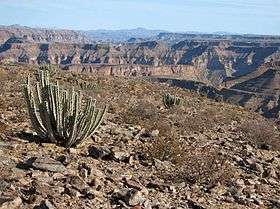

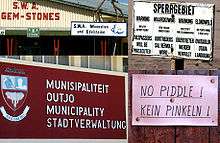

.svg.png)

.svg.png)
Countries.png)